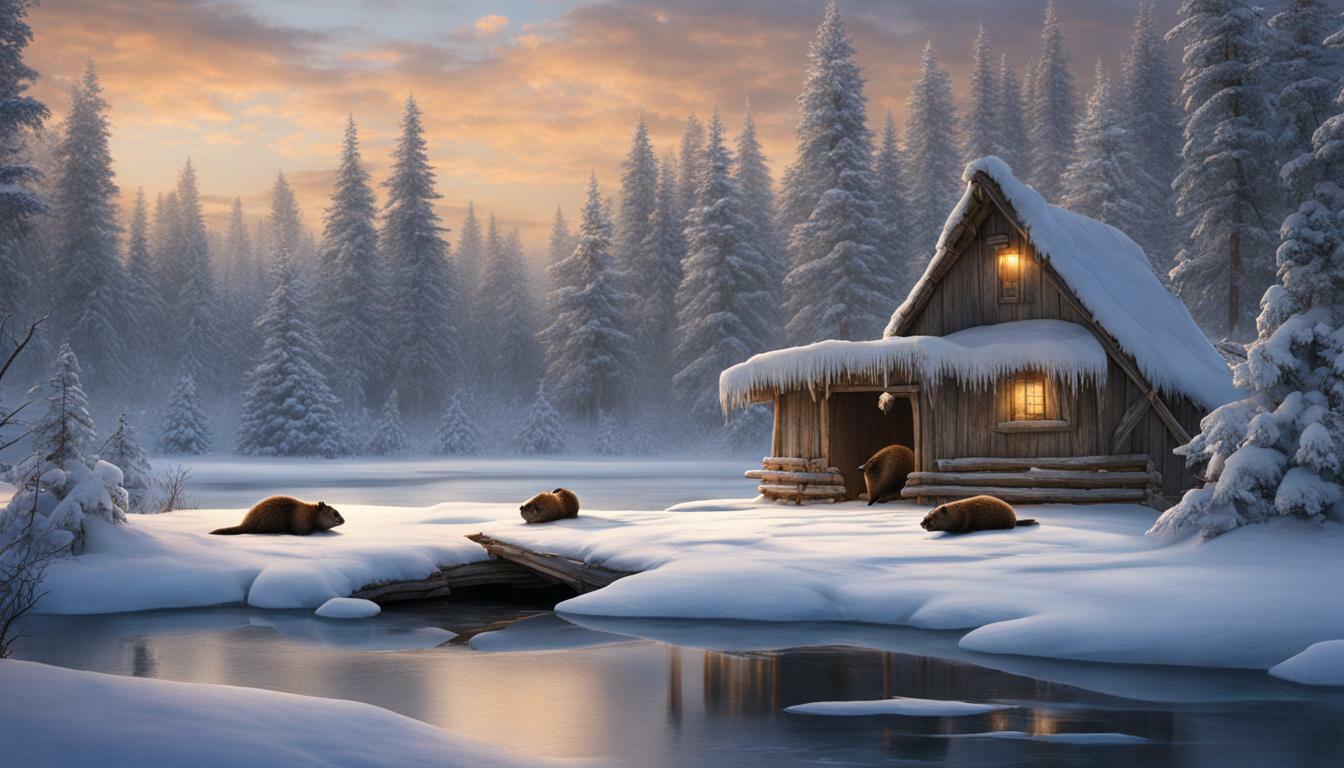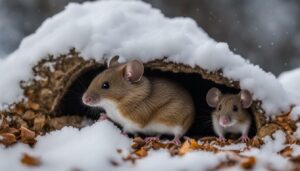Have you ever wondered where beavers go in the winter and if they hibernate like other animals? Well, you’re about to find out! Beavers have some unique strategies for surviving the cold winter months.
Key Takeaways:
- Beavers do not migrate or hibernate during winter. They stay in their home pond, stream, or lake.
- Beavers swim under the ice to move around and gather resources.
- Thicker fur helps beavers stay warm in colder climates.
- Beavers build lodges made of mud, sticks, and logs as their homes.
- These lodges have underwater entrances and are strategically built for protection.
Beavers Stay in Their Home Pond
Unlike many animals that migrate or hibernate during the winter, beavers prefer to stay in their familiar surroundings. These industrious mammals do not venture far from their home pond, stream, or lake, even in the coldest months. While other wildlife may seek warmer climates or burrow underground for hibernation, beavers have unique adaptations that allow them to thrive in the winter.
One of the remarkable behaviors of beavers during winter is their ability to swim under the ice. As the water freezes, beavers create an open area by continuously gnawing and maintaining a breathing hole. This opening allows them to move around and access the resources they need for survival. Beavers are excellent swimmers and can navigate through the icy waters using their webbed hind feet and paddle-shaped tail.
Beaver Lodges: Winter Homes
A significant reason why beavers can stay in their home pond throughout the winter is their skill at building lodges. These lodges serve as their winter homes and provide protection from predators and harsh weather conditions. Constructed from a combination of mud, sticks, and logs, beaver lodges are impressive structures that are built in the middle of shallow ponds or along riverbanks.
The lodges have a unique design, with underwater entrances that prevent easy access for predators like wolves or coyotes. This entrance also acts as a barrier against the cold outside temperatures, keeping the interior of the lodge relatively warm. Inside the lodge, beavers create separate chambers for nesting, eating, and storing food. These cozy spaces offer insulation and help retain heat, allowing the beavers to maintain a comfortable environment even in the midst of winter.
Table: Beaver Behavior in Winter
| Behavior | Description |
|---|---|
| Stay in their home pond | Beavers prefer to remain in their familiar surroundings throughout the winter. They do not migrate or hibernate. |
| Swim under the ice | Beavers can navigate through the icy waters by swimming under the frozen surface, using their webbed hind feet and tail. |
| Build lodges | Beavers construct impressive lodges made of mud, sticks, and logs. These lodges provide shelter and protection from predators. |
In summary, beavers have fascinating winter behavior. They stay in their home pond, stream, or lake, swimming under the ice to access resources. With their skillful lodge-building abilities, beavers create safe and warm havens for themselves. This unique adaptation enables them to survive the harsh winter conditions, making them true champions of resilience in nature.
Beavers Swim Under the Ice
Despite the freezing temperatures, beavers are excellent swimmers and are able to navigate beneath the ice. In winter, when their ponds and lakes are frozen over, beavers rely on their strong swimming abilities to move around and gather resources. They create a network of underwater tunnels and passageways, allowing them to access different areas of their habitat and locate food.
Beavers’ ability to swim under the ice is made possible by their unique physiological adaptations. Their bodies are streamlined, with webbed hind feet and a muscular tail that acts like a rudder, enabling them to navigate efficiently through the water. They can hold their breath for up to 15 minutes, and their fur provides insulation, keeping their bodies warm as they move beneath the ice surface.
During the winter months, beavers prioritize gathering food to sustain themselves. They swim under the ice to reach their stored food supply, which they have strategically stashed near their lodges. Beavers are herbivores and feed on the inner bark of trees, particularly those belonging to the poplar, willow, and birch families. They use their sharp incisor teeth to chew through the bark, extracting the nutritious inner layer.
Beaver Dams in Winter
An important aspect of beaver activity in winter is the maintenance and repair of their dams. Beavers construct dams to create and maintain the deep water they need for their lodges. Despite the freezing conditions, beavers continue to add sticks, logs, and mud to their dams, reinforcing the structure and ensuring it remains intact. The dam-building process is crucial for regulating water levels, protecting their lodges, and providing a stable environment for the beaver colony during the winter months.
| Key Points | Beaver Activity in Winter |
|---|---|
| 1 | Beavers stay in their home pond, stream, or lake during winter. |
| 2 | They swim under the ice to move around and gather resources. |
| 3 | Beavers store food near their lodges and venture out to gather twigs and bark. |
| 4 | They build lodges in the middle of shallow ponds or along riverbanks. |
| 5 | Beavers have thick, waterproof coats and use their tails to store fat. |
Thicker Fur for Winter Warmth
To cope with the chilly winter conditions, beavers develop a thicker coat of fur to keep themselves warm. Their fur acts as insulation, providing a protective barrier against the cold. The dense fur traps air close to their bodies, preventing heat loss and keeping them cozy throughout the winter months.
Beaver fur is unique in its design. Each hair is equipped with tiny scales that interlock with one another, creating a waterproof barrier. This means that not only does the fur keep them warm by trapping air, but it also keeps them dry by repelling water. Even when swimming under the ice, beavers remain dry and warm, thanks to their remarkable fur.
Adapting to winter
Beavers also rely on their large, flat tails during winter. These tails store fat that acts as an additional source of insulation and energy. They can regulate their body temperature by controlling the blood flow to their tails, conserving heat when necessary. Additionally, the tail acts as a rudder when swimming and as a warning signal when slapped against the water’s surface.
With their thicker fur, waterproof coats, and specialized tails, beavers are well-equipped for winter survival. These adaptations, along with their ability to build lodges and store food, allow them to thrive in freezing temperatures. Next time you wonder what happens to beavers in the winter, remember that they stay close to home, swimming gracefully beneath the ice, and relying on their remarkable adaptations for warmth and survival.
| Adaptations for Winter | Benefits |
|---|---|
| Thicker fur | Insulation and warmth |
| Waterproof coat | Keeps beavers dry while swimming |
| Large, flat tail | Additional insulation and energy storage |
Building of Beaver Lodges
Beavers construct intricate lodges during the winter months to create a safe and warm habitat for themselves. These lodges are built using a combination of mud, sticks, and logs, and are strategically located in the middle of shallow ponds or along riverbanks. The construction process is a fascinating display of beavers’ engineering skills, as they meticulously shape and arrange the materials to create a sturdy structure that can withstand the harsh winter conditions.
Inside the lodge, the beavers create a cozy living space by lining the walls with soft materials such as grass and leaves. This insulation helps retain warmth and provides a comfortable shelter from the freezing temperatures outside. The lodges also have underwater entrances, allowing the beavers to enter and exit their homes without venturing onto the ice surface, where they could be vulnerable to predators.
Nesting Chambers and Escape Routes
Within the lodge, beavers construct multiple nesting chambers. These chambers are spacious rooms above the water level, where the beavers can rest, eat, and care for their young. They are also equipped with escape routes that lead to underwater tunnels. These tunnels serve as emergency exits in case the ice becomes unstable or predators approach the lodge. The beavers can quickly swim through these tunnels to reach the safety of the water.
| Advantages of Beaver Lodges | Benefits for Beavers |
|---|---|
| Protection from predators | Beavers can safely rest and sleep without fear of attacks. |
| Warmth and insulation | The lodges provide a cozy environment that helps the beavers maintain their body temperature. |
| Convenient access to food | Beavers can easily access their stored food supply without having to travel long distances. |
| Safe breeding grounds | The nesting chambers provide a secure space for beavers to raise their young. |
| Easy surveillance | The lodges offer an elevated vantage point for beavers to monitor their surroundings. |
Overall, the construction of beaver lodges during the winter months showcases their remarkable ability to adapt to their environment. By creating these well-designed structures, beavers ensure their survival and thrive in even the coldest of climates.
Underwater Entrances for Safety
The underwater entrances to beaver lodges serve as a clever defense mechanism against potential threats. These entrances are strategically located to provide a barrier between the beavers and their predators, ensuring their safety throughout the winter. By accessing their lodges from beneath the water’s surface, beavers create a natural barrier that hinders access to their living quarters.
Beavers are excellent swimmers and can easily navigate underwater, using their powerful tails to propel themselves forward. When they approach their lodges, they enter through the underwater entrances, which are typically small openings in the lodge’s foundation. These openings are just big enough for the beavers to squeeze through, but they are too narrow for larger predators to follow.
The underwater entrances also prevent the freezing of the lodge’s interior during the winter months. By entering through the water, beavers can maintain a stable temperature and keep their living space dry and cozy. The cold air above the water’s surface does not penetrate the lodge, providing the beavers with a warm and protected environment.
| Benefits of Underwater Entrances for Beavers |
|---|
| Protects against predators |
| Allows easy access to the lodge |
| Prevents freezing of the lodge’s interior |
| Provides a warm and dry living space |
The ingenuity of beavers’ underwater entrances showcases their remarkable adaptations for winter survival. These entrances not only serve as an effective defense mechanism but also contribute to the beaver’s ability to thrive in their winter habitat. By creating a safe and secure environment, beavers can successfully navigate through the colder months, ensuring their survival and well-being.
Food Storage and Gathering
Beavers prepare for the winter by stocking their food supply underwater and foraging for additional sustenance when needed. These resourceful creatures have a unique way of storing food to ensure they have enough to sustain them throughout the colder months. They cut down trees and gather twigs and branches, bringing them back to their lodges and creating a food cache underwater near their living quarters.
Not only do beavers store food, they also venture out under the ice to gather more twigs and bark from their favorite trees. They are excellent swimmers and can navigate under the frozen surface, using their sharp teeth to gnaw through the wood and gather the necessary nourishment. This allows them to supplement their stored food supply and ensure they have enough sustenance to survive the winter.
Table: Beaver Winter Food Sources
| Food Source | Benefits |
|---|---|
| Alder Trees | Rich in nutrients and easily accessible |
| Willow Trees | Provide a good source of fiber and nutrients |
| Poplar Trees | High in moisture content, helping to prevent dehydration |
| Bark | Contains nutrients and serves as an additional food source |
By stocking their food supply and continually gathering more resources, beavers ensure they have enough sustenance to last them throughout the winter. This adaptive behavior is essential for their survival in harsh climates, allowing them to thrive even during the coldest months of the year.
Thick and Waterproof Coats
Beavers have developed several remarkable adaptations, including their thick, waterproof coats and unique tail structure. These adaptations enable them to thrive in harsh winter conditions. Their dense fur is composed of two layers: a soft undercoat and a longer outer layer that is water-resistant. This combination provides insulation, keeping them warm and dry even in freezing temperatures.
In addition to their fur, beavers possess a specialized tail that plays a crucial role in their winter survival. Their flat, broad tail functions as a tool for various tasks. It helps them maintain balance while walking on land, acts as a rudder when swimming, and aids in communication with other beavers. Furthermore, beavers store fat in their tail, providing them with a reserve of energy during the lean winter months.
These adaptations, along with their sleek body shape, allow beavers to navigate through icy waters effortlessly. Their thick fur maintains a layer of warm air close to their bodies, acting as a natural insulator. This insulation, combined with their waterproof coats, prevents water from reaching their skin and helps regulate their body temperature.
| Adaptations for Winter Survival | Benefits |
|---|---|
| Thick, waterproof coats | Provides insulation and protects against water |
| Flat, broad tail | Aids in balance, swimming, and fat storage |
| Sleek body shape | Enables easy movement through icy waters |
With these adaptations, beavers are well-equipped to endure the challenges of winter. Their ability to regulate body temperature, store fat, and navigate icy environments ensures their survival during the colder seasons. While other animals may migrate or hibernate, beavers remain active, continuing their essential role in shaping and maintaining their aquatic habitats.
Beavers’ Winter Survival Tactics
From their behavior and construction skills to their physical adaptations, beavers have impressive strategies for surviving winter. In the colder months, these industrious creatures do not migrate or hibernate like many other animals. Instead, they stay in their home pond, stream, or lake and swim under the ice to gather resources.
One of their key survival tactics is the construction of beaver lodges. These lodges are made from mud, sticks, and logs, providing a sturdy shelter against the harsh winter elements. They are typically built in the middle of shallow ponds or along riverbanks, strategically placed to maximize safety from predators. What makes these lodges even more remarkable is their underwater entrances, which allow beavers to enter and exit without exposing themselves to potential threats.
In order to withstand the frigid temperatures, beavers have a few physical adaptations. Their fur becomes thicker and denser in winter, providing insulation and warmth. This adaptation allows them to stay active and continue foraging for food even in colder climates. Additionally, their thick and waterproof coats allow them to regulate their body temperature and store fat, ensuring their survival throughout the winter months.
| Beavers’ Winter Survival Tactics | Beaver Adaptations for Winter |
|---|---|
| Stay in home pond, stream, or lake | Thicker and denser fur for insulation |
| Swim under the ice to gather resources | Thick and waterproof coats for temperature regulation |
| Build lodges with underwater entrances | Tails used to store fat and aid in temperature regulation |
When it comes to food, beavers are well-prepared for winter. They store food underwater near their lodges, ensuring a readily available supply throughout the season. To obtain fresh supplies, beavers venture out under the ice to gather twigs and eat the bark off their favorite trees. This resourcefulness allows them to sustain themselves and maintain their energy levels during the colder months.
In conclusion, beavers have developed remarkable strategies to survive winter. Their ability to stay in their home pond, swim under the ice, build lodges, and store food underwater all contribute to their successful adaptation to the harsh winter conditions. With their physical adaptations and resourcefulness, beavers are truly impressive creatures when it comes to survival in the colder months.
Conclusion
In conclusion, beavers do not hibernate but stay in their home pond or lake, swimming under the ice and utilizing their lodges for shelter during the winter months. Unlike other animals that migrate or enter a state of hibernation, beavers have developed unique adaptations to survive the cold temperatures and scarcity of resources.
During winter, beavers rely on their thick, waterproof fur to keep them warm and insulated. Their fur becomes thicker to provide extra protection against the cold. Beavers also use their tail to store fat, which helps regulate their body temperature and provides a source of energy during the winter.
Beavers build their lodges using mud, sticks, and logs, creating a safe haven within the middle of shallow ponds or along riverbanks. These lodges have underwater entrances, allowing beavers to access their homes without exposing themselves to predators. The underwater entrances serve as a defense mechanism, providing additional protection during the winter months.
To sustain themselves throughout the winter, beavers store food underwater near their lodges. They venture out under the ice to gather twigs and eat the bark off their favorite trees. By strategically locating their lodges near a food source, beavers ensure they have a steady supply of nutrients during the colder months.
FAQ
Where do beavers go in the winter?
Beavers do not migrate or hibernate. They stay in their home pond, stream, or lake and swim under the ice.
Do beavers build homes for winter?
Yes, beavers build lodges made of mud, sticks, and logs as their homes. These lodges have underwater entrances and are built in the middle of shallow ponds or along riverbanks.
How do beavers survive the winter?
Beavers spend the winter inside their lodges, protected from predators. They also store food underwater near their lodges and swim under the ice to gather twigs and eat the bark off their favorite trees.
Why do beavers have thick fur in winter?
Beavers grow thicker fur in the winter to keep them warm in colder climates. Their fur provides insulation and helps them withstand the cold temperatures.
What are beaver lodges made of?
Beaver lodges are made of mud, sticks, and logs. These materials are used to create a secure and protective shelter for the beavers during the winter months.




